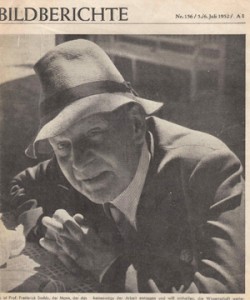The largest peanut in the world?
on Frederick Soddy, Nuclear chemist (1877-1956)
You’d like a world with bigger and juicier vegetables, for you and for everyone, wouldn’t you? And for everyone in the world to have enough to eat?
Well if you didn’t know better and this was 1959, you could achieve this by joining the Atomic Garden Club, one of several organisations aimed to make the world a better place founded under the auspices of the great pioneer of nuclear science and radioactivity, Frederick Soddy (pictured), and headed and run by his eccentric friends Colonel and Mrs Howorth (yes, you can definitely say that Colonel and Mrs Howorth were eccentric – but everything they did was in honour of Frederick Soddy, he was their guru, he was like a god to them …)
The programme they set out to promote was nothing less than to solve the world’s food problems for ever by encouraging farmers and market gardeners to irradiate their crops – which as well as making them grow FASTER and BIGGER, would also, hopefully, produce wonderful new MUTATIONS – so that before you could say John Wyndham the world’s starving would be munching away at radioactive fruit and vegetables and peanuts (I can’t just think whether it’s a vegetable or a fruit, but a peanut the size of a rugby ball was one of their famous successes).
AVS
More details about the Atomic Garden Club can be found on this Garden History Blog.
As well as practising chemistry, Soddy was also a keen mathematician, and Descartes’ Circle Theorem was renamed ‘Soddy’s Theorem’, if not because he discovered it, then because of the eccentric way in which he presented the theorem – in the form of a poem:
The Kiss Precise
by Frederick Soddy
For pairs of lips to kiss maybe
Involves no trigonometry.
‘Tis not so when four circles kiss
Each one the other three.
To bring this off the four must be
As three in one or one in three.
If one in three, beyond a doubt
Each gets three kisses from without.
If three in one, then is that one
Thrice kissed internally.
Four circles to the kissing come.
The smaller are the benter.
The bend is just the inverse of
The distance from the center.
Though their intrigue left Euclid dumb
There’s now no need for rule of thumb.
Since zero bend’s a dead straight line
And concave bends have minus sign,
The sum of the squares of all four bends
Is half the square of their sum.
To spy out spherical affairs
An oscular surveyor
Might find the task laborious,
The sphere is much the gayer,
And now besides the pair of pairs
A fifth sphere in the kissing shares.
Yet, signs and zero as before,
For each to kiss the other four
The square of the sum of all five bends
Is thrice the sum of their squares.
In _Nature_, June 20, 1936
A more easily digestible version of the theorem can be found on this very informative (external) site: http://pballew.net/soddy.html
